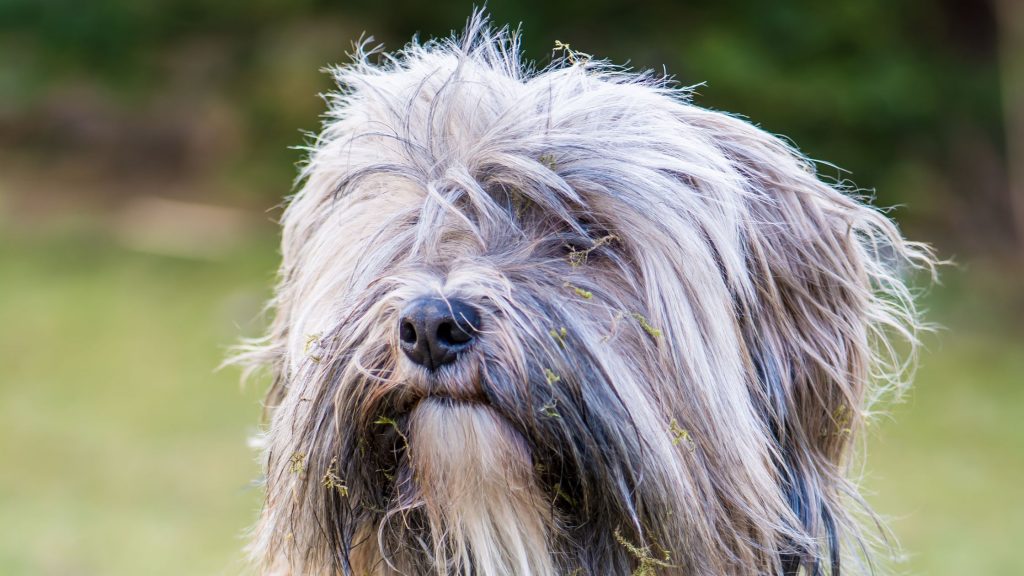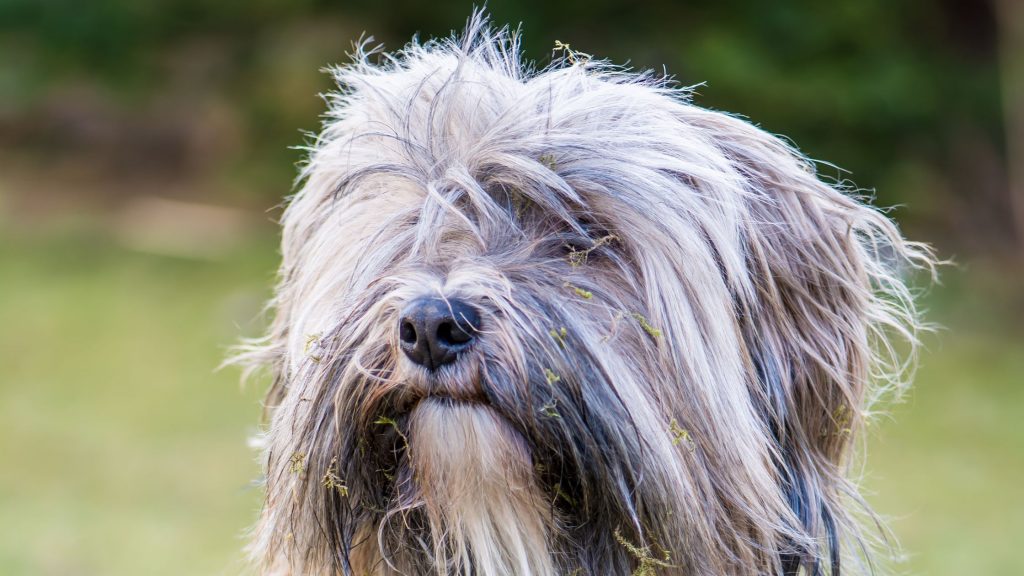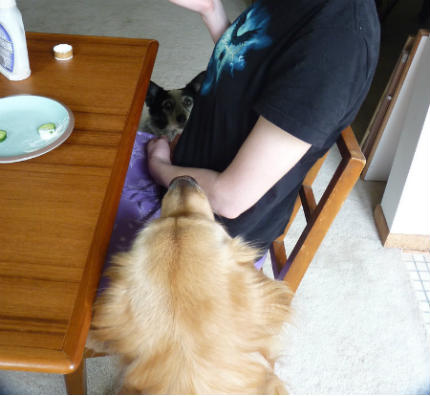The Tibetan Terrier has nothing to do with the rest of the terriers, and today it has become a perfect companion dog . It's in thousands of homes around the world, which means it has some much-appreciated qualities.
- Weight : 8 to 12 kilos
- Hair type: long and straight
- Character : calm, faithful and shy
- Health : very good
- Life expectancy : 12 to 14 years
Origins of the Tibetan Terrier
Their name leaves no room for doubt and these Tibetan terriers come from Tibet, which today belongs to China.
The monks had them in the monasteries to do all kinds of tasks. There they acted as guard dogs, but they also guided the flocks or kept the monks company, who kept the lineage unchanged for a long time.
In fact, the Tibetan Terrier is one of the best preserved breeds , the ones that have undergone the least changes over the centuries.
It is not known exactly when it originated, but it is believed that it was more than 2,000 years ago, when the Tibetans began a somewhat primitive kind of breed selection, separating large animals from small ones.
This is how the Tibetan Terrier and some other breeds such as the Tibetan Spaniel emerged, remaining with the monks without the general public knowing anything about them.
This Tibet Apso, the name by which the breed is also known, did not arrive in Europe until 1920, when a doctor named Agnes Gray received a puppy as a gift. She worked in Tibet and a couple she cared for gave her a puppy.
This dog went to England with her owner and breeding began with her, with the breed being recognized in 1930 by the English Kennel Club. From the old continent it moved to the United States and in 1956 the breed was recognized in that country.
The name terrier comes from the fact that foreigners saw it as similar to this type of European dog , which is why the breed is called the Tibetan Terrier, although it has nothing to do with them.

Main features
We are looking at a medium-sized dog, with a weight ranging from 8 to 12 kilos, and a height of between 35 and 45 cm.
It has a solid body and square shapes, as does its head. The eyes are round and are used as a measurement, since the breed standard calls for something a little peculiar.
This means that the distance from the nose (nose) to the eyes must be the same as the distance from the eyes to the base of the head.
Their ears hang from the skull, on the sides, and are V-shaped. As for their hair, they have a double layer to insulate themselves from inclement weather, something that can be a problem in hot places.
Regarding the tones of its coat, anything is allowed except chocolate and liver , so we can see specimens with very varied colors.
Character
As is evident, the character of the Tibetan Terrier has nothing to do with that of terriers, as it is very sweet and docile . He loves spending time with his loved ones and is always wary of strangers.
When it comes to living with children, he is not one of those dogs that can tolerate anything, like a Labrador. If these are very small, it is better to wait or opt for a different breed.
It is possible to educate the Tibetan Terrier, socialize it, but in the end there will be problems with the children, because they will not respect it and we do not know how it may react.
His character is tenacious and brave. With this we must be very careful, because he does not hesitate to play the hero, getting into very dangerous situations.
Well socialized, and always with the help of a professional, many animals of this breed have become therapy dogs, since they are sociable and love receiving attention from everyone.
Given their character, they do not feel good when they are alone . If they are going to have company for a good part of the day, they will have no problems living in a small apartment, but you should always ensure that they take long walks where they can play.

Tibetan Terrier Care
Like any long-haired dog, care begins with its grooming. Thus, we will have to brush him as often as possible, as this will prevent his coat from getting tangled or knotted.
Baths should also be frequent , especially if you live with us inside the house. You will have to put him in the bathtub at least once every two months. Because this period of time is very short, it is best to purchase a quality shampoo for long-coat dogs.
The ears are going to give us some work. Their hair also grows inside, so it is best to cut it often. This prevents dirt, humidity, or foreign objects from accumulating there.
It is very important that you exercise and you will need at least an hour a day . Walking with him is fun, because since he likes to play so much we will have a good time. Here we can teach him some tricks, because at that moment he will pay more attention to us.
Finally, we must insist on early socialization. He is an excellent dog, but as long as he has been socialized since he was a puppy. His character is somewhat distrustful by nature, something that we must overcome little by little.
Feeding
When we are going to choose the diet of the Tibet Apso, we must take into account that it is a small breed, with a high metabolism and that is why it tends to eat a lot.
Therefore, in order to avoid problems, the first thing we will do is divide the daily intake, choosing a special feed intended for these breeds, with small croquettes , not too hard and with a good flavor.
We will leave the food for larger dogs, since this type of breed has a hard time chewing the hard balls, something that can cause vomiting and stomach problems.
There are many brands that we can choose from, so we will go to our veterinarian or trusted pet store to ask, knowing that we must purchase premium feed, the ones that have a higher price.
With this, we ensure that in its composition there are only good ingredients, such as meats for human consumption, and we can even purchase a grain-free feed, which will help you maintain your weight and have better digestion.
At first, we will probably have to try several feeds until we find the right one . This will be the one that manages to please the animal, while producing small and compact feces, with the absence of bad odor.

Tibetan Terrier Health
The Tibetan Terrier is in very good health , the result of the isolation to which it has been subjected, which avoided intensive breeding programs and capricious modifications of its phenotype.
You may suffer from hip dysplasia
Although hip dysplasia is a pathology that is associated with large dogs , smaller dogs also suffer from it.
This is the case of the Tibet Apso, in which this disease can occur, although it is true that since their weight is less than that of a large breed dog, it affects them in a different way.
In fact, if it appears, it is usually treated with chondroprotectors, which help the joints to be in good condition, acting as a natural “lubricant.”
As always when we talk about dysplasia, we can improve our health by purchasing the dog from a reputable kennel , which has no problem certifying that the ancestors of the puppy we are taking are free of dysplasia.
No responsible breeder breeds dogs with dysplasia, but you should still ask for tests, such as x-rays of the parents.
In turn, and if the veterinarian considers it appropriate when seeing the dog walking, a special x-ray can be done to see if there is dysplasia and its degree.
They also suffer from vision problems
There are hardly any breeds that are free from eye diseases. In this case , progressive retinal atrophy, cataracts or ocular dislocation may appear .
Little can be done here, especially against ocular dislocation, so it is best to go to the vet for check-ups when he tells us, thus being able to detect these pathologies as soon as possible.
Other dog breeds that may interest you:












